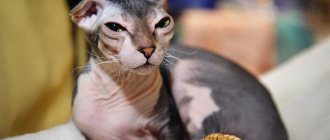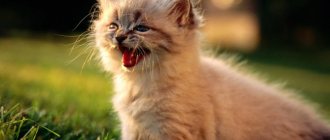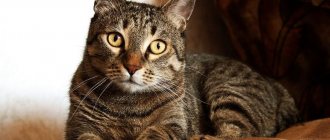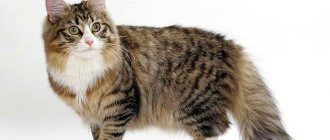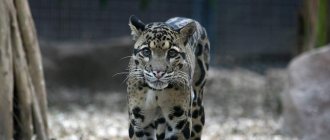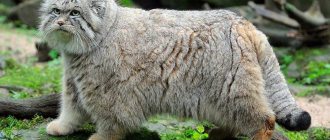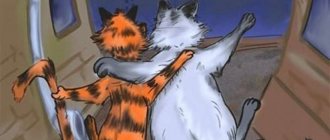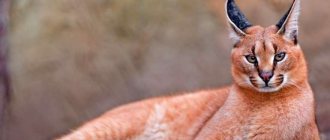Ukrainian Levkoy (Ukrainian Levkoy) is a breed of fold-eared hairless cats . They are graceful, long-legged and flexible animals with soft, elastic, wrinkled skin. The breed is not recognized by any major international felinological organization. Ukrainian Levkoys have intelligence, delicacy and an inquisitive mind. They are devoted to their owners, easily make contact, and are not vindictive. They are very inquisitive and will definitely examine your bag that you bring from the store or a new item that appears in the house. They are interested in literally everything, but especially what you are trying to hide from them. Levkoys get along well not only with children, but also with other pets, including small rodents.
Weight: about 5 kg. Dimensions: 26-32 cm. Cost (price) of a kitten: from 10,000-25,000 rubles (depending on the class of the kitten) Life expectancy: up to 12-15 years. Country of origin: Ukraine. Breed diseases: diseases of the cardiovascular, respiratory, digestive, urinary and nervous systems, diseases of the blood system, etc. The breed is recognized by felinological organizations: RUI.
Ukrainian Levkoy: buying a kitten, its feeding and health Nicknames for the Levkoy Tips for keeping the Ukrainian Levkoy Caring for the skin, eyes, ears, claws and teeth of the Levkoy
History of the origin of Ukrainian Levkoys
Ukrainian Levkoy is a young promising breed that appeared at the beginning of the 21st century . The authorship belongs to felinologist Elena Biryukova, who came up with the idea of creating a breed of hairless cats with an interesting appearance back in 2000. Elena spent a long time drawing sketches of the cat - gradually she understood what the ideal appearance should be and what breeds are needed to breed it.
The felinologist settled on the Don Sphynx and the Scottish fold cat . These breeds were ideal for creating a hairless cat with drooping ears. Elena decided to breed an original breed that would be radically different from the original breeds, but took their characteristic features.
The first kitten named Levkoy Primero was born in Elena's Lada cats nursery on January 21, 2004. The baby had velor skin, almost bald, unusual forward-curving ears and beautiful almond-shaped eyes.
The felinologist did not immediately decide on a name for the new breed . The kitten strongly reminded the author of a baby dragon or a lion cub. But one day Elena drew attention to the Levkoy flower, the petals of which resembled the shape of a baby’s ears, and decided to give the breed a romantic name - Ukrainian Levkoy.
The offspring of Levkoy Primero numbered 40 individuals at the beginning of 2006 . In December 2007, the breed was presented at the first special breed WCF - the Ukrainian Levkoy ring. In September 2010, Levkoys received the right to participate in the Ukrainian Championship under the ICFA RUI system.
Levkoy care and maintenance
Nature has rewarded this breed with quick wit and great intelligence. If the owner starts raising a pet during adolescence (at 3-4 months), the animal will grow up clean and tidy. Levkoys quickly get used to the tray, scratching post and other useful things. With a competent approach to the issue, you can raise a sensitive and unusually obedient cat.
Since the breed was bred artificially and is exotic, such cats should be cared for a little differently than ordinary ones. Here are some important details about caring for your pet:
- High quality shampoo. Although they do not need to be combed, due to the abundant secretion of sebum, they will have to be bathed more often than long-haired dogs.
- A balanced diet and active play are essential to ensure adequate energy production for the health of your Levy.
- Standard hygiene procedures include cleaning ears and teeth, trimming nails.
With good care, Ukrainian Levkoys live 10-14 years.
Diseases of the Sphynx Levkoy
It is difficult to name a disease to which the Ukrainian Levko . But this does not mean that a representative of the breed will necessarily have a certain illness.
Things to watch out for:
- Sudden changes in temperature. Due to drafts, respiratory and urinary tract diseases are possible.
- Problems with the cardiovascular, nervous or circulatory system.
- Overeating or poor nutrition can cause digestive problems.
Conclusions about the breed
global $ads_google;
//data-ad-slot=”2475549904″ $ads_google = empty($ads_google) ? false : true; ?> if ($ads_google == false) {?> $ads_google = true; ?> } ?> So, who is the Ukrainian Levkoy :
- Little family member. The cat is friendly, polite and equally kind to all household members. Gets along well with children and other animals, including small rodents. Almost never starts quarrels.
- A whimsical flower. The Kiev Sphinx is distinguished by its original and sometimes painful beauty. Due to its uniqueness, it requires special care, love and care.
- A sociable and cheerful alien. This charming combination was inherited by the left-handed cats from the Don hairless cats. Communication with such a pet will not leave anyone indifferent.
The Ukrainian cat is a priceless find. He can be different: silent and talkative, sensitive and frisky, businesslike and playful. But always loving and attentive.
Description of the breed
The Ukrainian Levkoy breed is not yet recognized by the International Feline Organization, but in June 2012 the cats were officially presented to the WCF Board and a breed standard was submitted for consideration.
The preliminary breed standard states that the Ukrainian Levkoy is a hairless, fold-eared cat of medium size, with a long body and well-developed muscles. According to tactile sensations, animals are soft and hot. Female Ukrainian Levkoys are significantly smaller in size than males. Weight is 3-5 kg, height is 26-32 cm, life expectancy is 12-14 years.
A distinctive feature of the leftkoy is its angular head (modified wedge) with a stepped profile. The cheekbones and brow ridges are sharply defined by the cheekbones. The ratio of the length of the skull to the total length of the head is 2:3. The skull is wide, slightly convex, with vertical wrinkles that diverge horizontally above the eyes.
The nose is straight, of medium length, pronounced stop . The muzzle is moderately long, wide and rounded. The jaws and chin are developed. The nose forms a vertical line with the lower point of the chin.
The vibrissae are thick, convoluted , and may break off briefly or be completely absent.
The ears are small, pressed against the skull or slightly raised. The auricle is flower-shaped, with one or two horizontal folds.
Reference. The breeder form of the Ukrainian Levkoy Strait (ULV 71) is presented, which is distinguished by straight, wide-open ears. Self-breeding is not allowed. According to the standard, the Levkoy has only curled or straight ears (Fold or Straight).
The eyes are medium-sized , almond-shaped, slanted. Any iris color.
The body is of medium length , dense, muscular, hot. The chest and croup are wide. The belly is noticeable, the groin line is deep. The limbs are strong, the forearms are straight, the paws are dense, rounded, the fingers are long and mobile.
The tail is straight , medium length, flexible, strong, tapering towards the tip. Most often hairless, but sometimes covered with delicate, thick, close-lying wavy hair or islands of hair.
The skin is elastic, there are many folds on the head, neck, armpits and groin . In young individuals, the muzzle is sometimes covered with short, fine hair. The hair on the cheeks and at the base of the ears is longer. The breed is characterized by the appearance of seasonal hairiness throughout the body. Residual fur (“flock”) up to 2 mm long, light hair on the face, tail, and limbs are allowed. Sparse “brushpoint” hair on the front surface of the legs to the elbows and hocks is acceptable.
Representatives of the “bristle” brush variation do not participate in exhibitions and are allowed exclusively for breeding. Kittens are born hairless, with Rex wavy hair, a bald spot on the head, and always with curled whiskers. Any colors are acceptable.
Individuals with:
- semi-erect ears;
- long narrow head;
- long convex bridge of the nose;
- round, straight-set or small, deep-set eyes;
- light, weak or stretched body;
- creaking, short tail;
- underbite.
At exhibitions, cats with straight hair, turned-up eyelids, erect ears, a stiff tail, or an underbite of more than 2 mm are disqualified.
Character and habits
The Levkoy cat is inquisitive, active and intelligent with a complete lack of aggression . The Levkoy cat is gentle and friendly, quickly becomes attached to a person, and can sit next to him or lie on his lap for hours. Owners of Levkoys say that they resemble dogs more than cats. These animals are faithful and devoted, easily finding a common language with all family members. It doesn’t matter whether it’s an adult, a child, another cat, a dog or a hamster. Peace, friendship, chewing gum - the motto of their cat's life.
Levkoys are extremely smart individuals, they feel the mood of their owners and will not bother if this is inappropriate, or they will stay nearby and purr, trying to correct the situation and lift the mood.
The Ukrainian Sphynx is playful and active, walks on a leash and accompanies its owner on walks . He loves to chase balls and tinker with wind-up mice, and loves to run. Levkoy owners note that communicating with these amazing cats brings them real pleasure.
When a cat lacks the attention of its owner, it gently touches it with its paw and meows. This is how she invites a person to play or have a heart-to-heart talk. This is an ideal breed for older people - with them the owner will not be left alone.
Levkoy is raised from the moment it appears in the house . The kitten is trained to be on a leash if the plans include walking it outside. Show the sleeping area, litter tray, location of food and water bowls. If the owner notices that the baby is trying to do his “big” or “little” things in the wrong place, he should be immediately taken to the tray.
The kitten must become accustomed to hygiene procedures , so trimming its claws and cleaning its eyes and ears begins as early as possible. To attract attention to the scratching post, a few drops of valerian are applied to it, and an attempt to sharpen the claws on the furniture is stopped with a strict “No!” Representatives of the breed are very smart, so you won’t have to repeat it 100 times. Children should not be physically punished; a severe reprimand is sufficient. In addition, their innate intelligence does not allow them to go to the toilet in the wrong places and even litter the litter granules.
Interesting Facts
Here are some interesting facts about the breed :
- Owners of Levkoy Sphynxes compare the skin of their pets to the delicate and soft skin of a baby.
- The female is very easy to distinguish from the male . Cats are much larger than cats.
- There are no restrictions in terms of coat color ; any color is acceptable.
- The body temperature of left-handed cats reaches 40°C, so many people think that the cats are hot.
- Due to the lack of fur on the body of cats, any flaws are visible - excessive thinness or fullness.
- Levkoy is suitable for allergy sufferers - people intolerant to cat hair. This allows them to compete with sphinxes.
Characteristics of Levkoys
Ukrainian Levkoy cats are intellectuals in the full sense of the word. They behave in a cultured and reserved manner. Hairless cats themselves will never create trouble, and if they accidentally find themselves in an uncomfortable situation, thanks to their innate ingenuity and caution, they will get out of it with dignity.
Sphynxes from Ukraine are easy to teach simple tricks and even commands. The cat learns something new with interest and real pleasure. The owner who prefers the “gingerbread” method instead of the “stick” method in training and shows patience will be rewarded with significant successes for his feline companion. Representatives of this breed receive emotional support from praise. Approval and support pushes them to accomplish other feats.
Ukrainian Levkoys are gentle, sensitive creatures. They have a hard time withstanding criticism, not to mention physical punishment, which can cause serious harm to their health. When communicating with these bald creatures, it is worth remembering their fragility and vulnerability. In any, even extreme, case, a person, if desired, will be able to find a common language with his understanding smaller brothers. But, regardless of laziness or busyness, the potential of the Ukrainian lefty needs to be developed daily.
An inquisitive Kiev resident loves to communicate with family members and take an active part in family affairs. An exotic cat loves outdoor games and is literally thrilled by affection, but will not bother its owner with its endless love. The pet will wait until the person is free and will be able to pay attention exclusively to him. Levkoys like it when people talk to them, and they themselves are attentive, talkative interlocutors.
Pros and cons of the breed
Advantages of the breed:
- peaceful character;
- extraordinary mind;
- exotic appearance;
- kindness;
- intelligence;
- intelligence;
- activity;
- playfulness;
- friendliness;
- affectionateness;
- lack of wool.
Among the shortcomings it is worth highlighting:
- tendency to infectious diseases and pathologies of internal organs;
- dependence on a person;
- skin discharge;
- noisiness;
- special care.
Castration and sterilization
If the owners do not make plans for offspring, then castration or sterilization is carried out. The operation can be performed from six months of age. It takes a quarter of an hour and is performed under general anesthesia. The recovery period may take up to two weeks. During this period, the pet needs special care. Seam treatment is required (for sterilized cats) and additional protection from temperature changes. It is important for a neutered cat not to be allowed to lick its wounds. After castration, the animal becomes calmer and more affectionate.
Caring for the breed
Ukrainian Levkoys are famous for their unpretentiousness , so even an extremely busy owner can cope with caring for them.
Before bringing the kitten home, prepare the room : remove sharp and life-threatening objects, hide valuables. Windows in the house are kept closed or covered with screens. They also block the exit to the balcony and remove potentially dangerous plants that the baby might want to taste.
A soft old blanket or a bed from a pet store is suitable as a bed There are multi-storey houses for sale along with a scratching post.
Advice. Cats love toys, so there should be a lot of them, since there is a large assortment in stores.
The delicate skin of the Levkoy needs special care . The sebaceous glands produce a special secretion, which in cats with fur is distributed throughout the hairs, and in hairless cats it is collected on the skin. The secretion in large quantities causes an untidy smell, and you don’t want to touch the cat at all. Alcohol-free wet wipes are suitable for removing it.
Also, once every 1-2 weeks, cats are given bath days . For washing, use special shampoos for hairless cats. After water procedures, the skin is lubricated with cream to prevent dryness and flaking. Levkoys do not like such procedures, but if you start bathing them from an early age, you can minimize stress in adulthood.
The tail is wiped with a special disinfectant 1-2 times a week . Rare hairs can be removed with tweezers. Nails are trimmed once every 2-3 weeks with a special nail clipper. Remove the transparent part of the claw, being careful not to catch the vessels.
The ears are inspected and cleaned once every 2 weeks using wet wipes, sponges, and cotton wool. After cleaning, the ears are lubricated with cream or Vaseline. If signs of inflammation or ear mites are detected, contact a veterinarian. The oral cavity is cleaned with toothpaste and a cat brush or wipes.
Eyes are cleaned with wet wipes or a cotton pad moistened with warm boiled water.
Diet
Levkoys have an excellent metabolism, as well as an excellent appetite . Owners should monitor the amount of food consumed to prevent obesity. The pet's diet must be balanced, and portions are given strictly according to schedule.
When choosing a natural type of nutrition, it is recommended to give preference:
- beef, veal, chicken, turkey, rabbit;
- liver, necks, hearts, stomachs;
- sardine, cod, hake, salmon, trout, notothenia;
- kefir, yogurt, cottage cheese, cream;
- eggs (1 yolk per week);
- fats of animal and vegetable origin (0.5 tsp per day);
- cauliflower, carrots, zucchini, beets;
- rice, millet, buckwheat;
- parsley, dill, lettuce, as well as green grass (barley, oats).
Prohibited:
- lamb, pork;
- raw egg white;
- salt, spices;
- onion garlic;
- smoked meats, canned food;
- sweets;
- spicy, fried, fatty foods;
- potatoes and pasta.
When choosing a dry type of food, it is recommended to choose at least premium food for hairless cats . They contain a complex of vitamins and minerals, the norm of protein, fats and carbohydrates. Adults are fed 3 times a day, babies - 4-5 times. Animals are provided with access to clean and cool water, which must be changed regularly.
Interesting. Many cat owners observe funny behavior - cats refuse to drink water from a bowl, preferring running water from the tap. There is an explanation for this. Cats are getters by nature and in the wild drink water from open reservoirs, while domestic cats instead lap up the life-giving moisture from the water supply, considering it cooler. In addition, the instinct of inaccessibility kicks in, and the water in the bowl is just that, so it’s not at all interesting.
Diseases and common health problems
Ukrainian Levkoys suffer from congenital anomalies and are predisposed to breed diseases :
- “Bent ear” in babies appears at the age of 4 weeks. The ear is reduced in size and the tip is strongly bent forward.
- "Curled ear" - the tips of the ears are curved back.
- “Denovo” - folds on the ears, the tips are curved and diverge to the sides.
- “Cleft palate” is a deformation of the palate.
- diseases .
- Anomalies in the structure of the eyeballs.
- Neuromuscular system disorders
Ukrainian Levkoys are predisposed to :
- to metabolic disorders;
- hypovitaminosis;
- hernia and uterine prolapse;
- mastitis;
- oncology;
- rabies;
- dermatomycosis;
- Aujeszky's disease;
- infectious peritonitis;
- panleukopenia;
- infectious rhinotracheitis;
- chlamydia;
- salmonellosis.
To prevent infectious diseases, cats are vaccinated . The first vaccination is given at 2 months and repeated after 2 weeks. The next vaccination is given at six months, then a year. Adults are vaccinated annually. 114 days before vaccination, deworming is carried out.
Health
Hairless pets are especially susceptible to skin diseases and colds. For prevention, the following measures should be taken:
- Maintain the temperature in the room where the cat lives from 20 ⁰С to 25 ⁰С, avoid drafts.
- Limit your pet's time in direct sunlight or near heaters to avoid burns or heat shock.
- In winter, dress the cat in special clothes to prevent hypothermia.
- Monitor the condition of the cat's lacrimal glands and ear canals, not forgetting about regular hygiene procedures.
- Monitor your pet's diet to rule out gastrointestinal diseases and excess weight problems.
- Vaccinate the animal in a timely manner (primary vaccination at 2 months, after reaching the age of 1 year - annually).
If the requirements are met correctly, hairless cats live a full life, the normal duration of which is 15-20 years.
The choice of a hairless cat as a pet is often due to the presence of allergic diseases. It should be understood that allergies are most often caused not by the pet’s fur itself, but by the D1 protein produced by the cat’s glands. Before purchasing an animal, you should conduct the necessary tests to identify the source of the allergy. If the allergen is protein D1, the patient is advised to limit contact with any cats.
Breeding Ukrainian Levkoys
Levkoy is a breed of cat that is bred exclusively with the Straight breeder form . To maintain the phenotype, straight-haired animals with curled ears, born from Ukrainian Levkoys, are needed. They are mated with representatives of their own breed, the St. Petersburg and Don Sphynxes.
A cat bears kittens for 63–65 days . Pregnancy can be determined by pink nipples. In the fifth week, the cat is actively gaining weight, in the sixth week the nipples fill with milk, and toxicosis appears.
Usually, Ukrainian Levkoy cats cope with childbirth on their own , without any problems. Sometimes the owner's help is required, or in extreme cases, a veterinarian.
Appearance standard
Of all the types of hairless cats, three types of Sphynxes have passed all stages of official recognition: Canadian, Donskoy, Peterbald. Each breed is characterized by its own standards, compliance with which is monitored by international organizations. The largest breeders' association is ISBFA.
Appearance description:
- Muscular body of medium size, distinguished by grace and fine lines.
- There is practically no hair. A few short hairs create a thin velvety layer on the surface of the body.
- The specific location of skin folds indicates genetic differences.
- The presence of vibrissae, fluffy brushes on the limbs, and eyebrows is acceptable.
The geometry of the body and head of animals is different, making it possible to accurately determine whether a cat belongs to one type or another. A common feature is the active temperament and attachment to the owner, usually characteristic of dogs.
Price and how to choose correctly
For a Ukrainian Levkoy kitten, it is better to go to specialized nurseries to avoid unpleasant surprises. The baby must be healthy and active, friendly and inquisitive, his appearance must correspond to the breed standard :
- wedge-shaped head;
- pronounced cheekbones and eyebrows;
- muzzle of medium length;
- developed jaws and chin;
- almond-shaped eyes;
- folds on the neck, head in the armpits, groin.
List of nurseries in Russia:
- MISS MISTIC KISA'S (St. Petersburg);
- Island Of Love (St. Petersburg);
- GOLDEN LEVKOJ (St. Petersburg).
The price of levkoy varies from 2,000 to 30,000 rubles . For a minimal cost you will receive a kitten without documents, most likely unvaccinated. The higher the price, the higher the chances of purchasing a purebred Levkoy with all the necessary documents.
Colors
The left-handed dog can have any color - plain, with patterns, spotted. Light and smoky colors are most common, and red ones are less common.
Plain gesso:
- Black (or slate gray),
- Blue,
- Chocolate (all shades from mocha to latte),
- Lilac (reminiscent of lavender shade),
- Red (always give tortoiseshell kittens),
- Cream (in union with other flowers they produce offspring of tortoiseshell shades),
- White.
According to their coat, Levkoys come in the following varieties:
- Bald (completely without hair),
- Velor (with wool up to 3 mm),
- Flock (up to 2 mm fur),
- Brushpoint (rare areas of fur),
Bristlebrush (allowed for breeding, but does not participate in exhibitions).
View this post on Instagram
Bravely visited the doctor and received documents, the lady is growing
